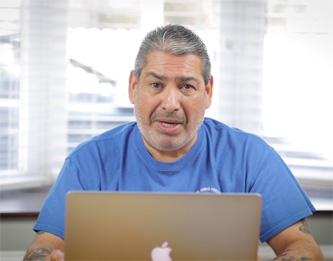What if, typically in a prison or mental health setting, staff are faced with restraining someone, who may spit or cough at them, with the effect – whether out of deliberate malice, or unknowingly if the person is suffering from dementia – of possibly infecting the staffer with the coronavirus? That is the question addressed by the physical intervention trainer Mark Dawes in an eight-minute video.
Mark, pictured, of training company NFPS, said he had been asked for advice. What to do – put the person spitting or coughing in a secure, even locked, room? Restrain the person with handcuffs, or ‘softcuffs’? Provide protective equipment such as goggles and face-masks for the staff doing the restraint, and put a spit hood on the person doing the coughing?
Mark’s first point was that coughing and spitting at someone, intending to pass on the virus – or threatening to do so – was battery, in law: “It’s an assault, and an arrestable offence – let’s make this clear; they are committing a crime.”
He likened such ‘toxic’ behaviour by someone, that is going to affect staff, to the safe carrying and transport of chemicals, that if spilt in transit would have to be cordoned off, and contained, and dealt with by people with PPE (personal protective equipment). In each case, he said, there’s need for precautions.
If staff are expected to restrain someone, look at the risk factors, Mark said. In the video and offered for free as a download, is a risk assessment, in terms of (as with any other risk assessment) of hazard, likelihood and severity. One thing he stressed, ‘and I have been doing this for 30 years’, was that if you want staff to actually restrain someone, who may have the Covid-19 virus, then there are risk factors to consider – the physical skills used to restrain someone; such as, prolonged restraint increases risks to everyone, because staff get fatigued. Mark’s point; intervention should be done ‘quickly and effectively’. That said, some restraint positions increase the risk of death, such as being seated bent forward, and in ‘supine positions’ – and in any case, someone on their back can still spit and cough at you.
To bring someone under control as fast as possible, ‘that means they [the staff] are going to have to use even pain-compliance techniques’. And if an employer does not give staff appropriate and effective skills to bring someone under control quickly, ‘there’s huge liability with this,’ Mark Dawes added. A risk may also be to the person being restrained, Mark pointed out, if that person already has a respiratory problem.
For a copy of Mark Dawes’ advice, he asks you to opt in by email; he plans to enlarge on the advice, and to send out updates. His final point is that the Health and Safety at Work Act 1974 still applies.
Visit https://restraintandcovid19.nfps.info/optin1585222408084.










